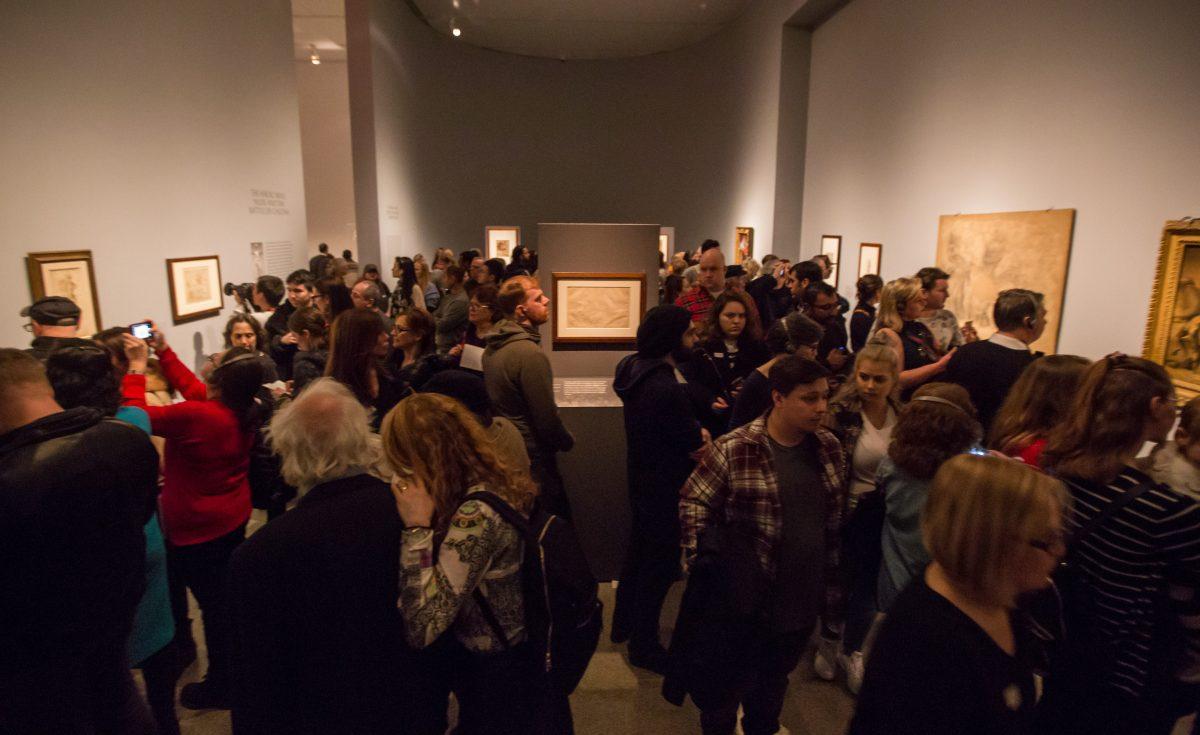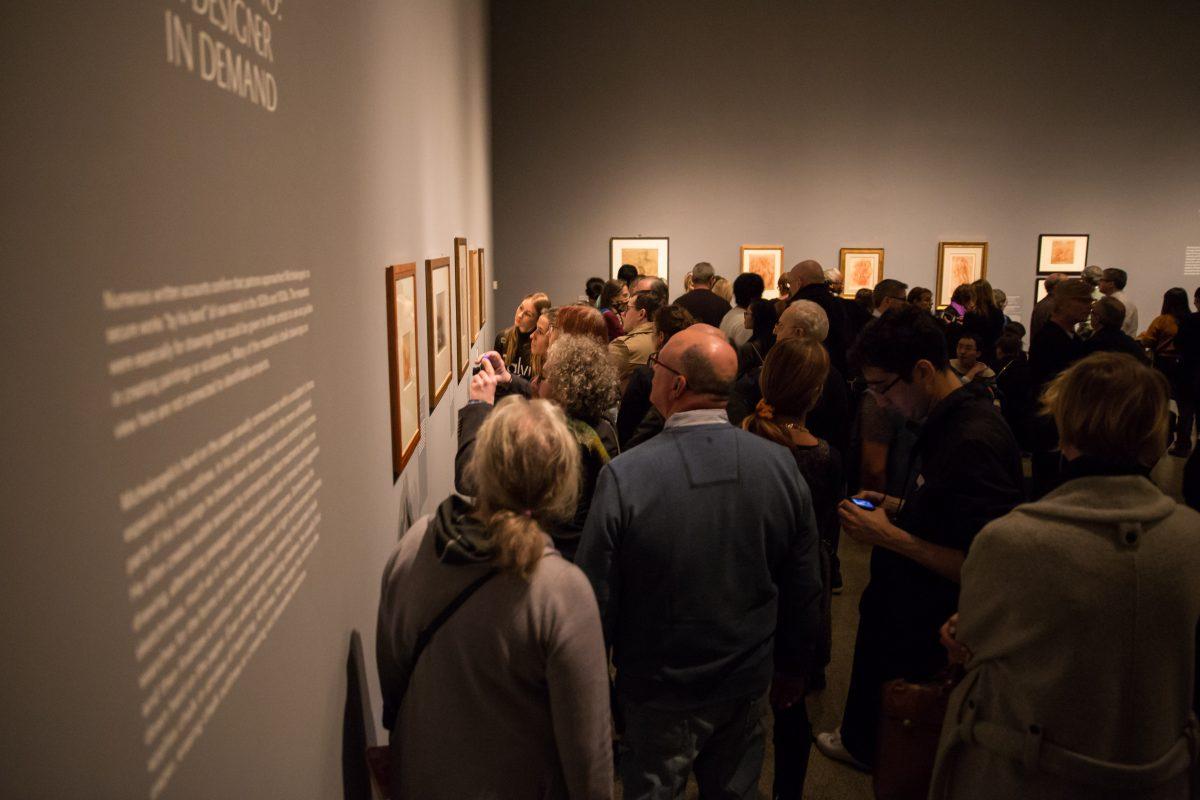NEW YORK—She brought Michelangelo to the center stage of arts and culture for 91 days with the “Michelangelo: Divine Draftsman and Designer” exhibition at The Metropolitan Museum of Art. Long after the curtain closed on Feb. 12, the applause for “Il Divino,” as the artist is called, continues.
Dr. Carmen Bambach, the curator and organizer of the exhibition, was not surprised that more than 700,000 people visited the exhibition. It was the 10th most popular exhibition ever held at The Met in its 148-year history. “Michelangelo was a rock star of the year!” Bambach said, smiling in her office, surrounded by books and documents.


She had dedicated eight years to curating and organizing the exhibition. Those eight years, however, were merely the distillation of researching and deeply studying Michelangelo’s life and work for more than three decades. Her connection with the Renaissance master goes back even earlier when, at the age of 10, she started drawing and copying Michelangelo’s drawings from a book her mother had given her.
Born in Chile, she immigrated with her family to the United States in 1974, shortly after the Chilean coup d’état. Having grown up while facing all kinds of challenges, she said that the idea of taking intellectual risks is second nature to her. The education she received, the professors and mentors she had in college at Yale University, also encouraged her intellectual courage.
When she was studying architecture and art history as a senior at Yale when she was 20, she discovered a Michelangelo drawing that had been published incorrectly: It was placed upside down on the page and labeled as an armpit of a figure. She suggested, instead, that it was the foreshortened head of Haman in the fresco of the “Punishment of Haman” on the Sistine Chapel ceiling. In time, she took a full-scale transparency copy of the drawing to Fabrizio Mancinelli, who was directing the cleaning of the Sistine Chapel ceiling from 1986 to 1994. When she climbed up the scaffolding and placed the transparency on Haman’s head, it matched perfectly. That was a significant springboard to her graduate degrees in art history and her illustrious career as an art historian.
Now, Bambach finds herself at the height of her creative intellectual powers.
In this exclusive interview, Bambach shared some of the challenges she faced and the insights she experienced in the process of curating, organizing, and writing about the exhibition.

The Epoch Times: An exhibition that “focuses so much on the interior world and personality of an artist, particularly a Renaissance artist,” as you have said, is very rare. What are some other intellectual risks you took for the exhibition? Carmen Bambach: The point was to create an arena, an ambiance, where there was a sense of stepping into that private world of Michelangelo. Old master drawings are less accessible to people, so I felt it was very important to demonstrate to the public that looking at the drawings is the same as stepping into his creative world. These are objects of great intimacy and connectivity with the viewer. We can really see the artist thinking on the paper.
The Epoch Times: How do you feel the role of drawing has changed since Michelangelo and his time? Is “disegno” (in the sense of drawing and designing with a particular aesthetic and ethical pursuit, similar to how it was cultivated during the Renaissance) still relevant? Dr. Bambach: I would say that disegno is more relevant today than ever. The lessons that Michelangelo provides for us is that for him the conceptualized ideas, in terms of design and drawing done by his hand, are inextricably linked. This sense of the artist’s hand—the eye, the mind of the artist—is kind of a metaphysical state of being for him.
The lesson here for artists today is that we need to look back again and value the product done by the artist’s hand as much as a conceptual idea. Michelangelo shows us that these are not opposite goals; these are, in fact, intertwined and complementary.
The Epoch Times: What would you say about Michelangelo’s passion for creating in connection with his beliefs, in Neoplatonism, in Christianity? Dr. Bambach: We come back again to the drawings as the most forceful and immediate expression of this belief in an intellectual life. The subject matter is often engaging with classical mythology. The drawings that show us Michelangelo’s profound spirituality is the Pietà drawing that he does for Vittoria Colonna, or the crucifixion. There is a sense of passionate belief in a mystical quality, this communion between God and the person. Michelangelo was a poet, and much of the Neoplatonic way of his thinking is expressed in the ways that he writes about love, spiritual love, and love as a process of attaining purity of being by which the person is gradually released from the fetters of the human body; so it’s about gradual ascent to a spiritual state.
Some of the Florentine Neoplatonists maintained that the most perfect and the most pure form of love was male love … So there is this culture that is very erudite, very knowledgeable, very versed in the classics, that embraces Neoplatonic philosophy. And it is not about carnal love; it is also not in the sense that we use the modern term, “platonic love.” It is about states of being that are about purity and the spirit.

The Epoch Times: How does his passionate poetry for his friend Tommaso de' Cavalieri contrast with his passionate poetry for Vittoria Colonna? Dr. Bambach: Michelangelo experiences a gradual, spiritual conversion. We have to understand that the Michelangelo of the early 1530s, when he is madly in love with Tommaso de' Cavalieri, that is a moment in his life. When we are talking about Vittoria Colonna, whom he meets probably in 1538, we are looking at a moment when Michelangelo is consumed by mysticism. Vittoria Colonna, herself, who was a widow and had been for some time committed to convent life, even stops writing the Petrarchan poetry that is all about love, and by the time that she meets Michelangelo, she’s only writing “sonetti spirituali,” or spiritual sonnets.
Remember that Vittoria Colonna was a highly educated woman, the famous and foremost literary woman of her time. Her religious commitment led her, for example, to castigate her body in a way that she became very frail. She suffered a great deal: She would not eat very much, she would wear a hair shirt under her nun’s habit, all sorts of things which are about mortifying the flesh. So this is the Vittoria Colonna whom Michelangelo meets, and in many ways he catches the mystical bug, let’s say, from this very ascetic Vittoria Colonna. You really see that meeting her was a turning point in his life. None of this is clear, unless we think of the artist as a person rather than as just the maker of these drawings, “The Last Judgment,” and all that.
In a sense, it was the drawings that probably reveal this journey and these dimensions in the deepest way because drawings are so private. He did drawings for himself, or for his closest intimate friends.
The Epoch Times: It’s almost like entering his mind, in a way. Dr. Bambach: That’s right. Michelangelo’s drawings have a very strong autobiographical quality. The depth, almost ferocity, of feeling is amply communicated by the drawings. You see, for example, that the center of his artistic vocabulary is the male nude body, and in a sense, it provides the building blocks for his artistic vision.
The Epoch Times: Some of his little quick sketches are not necessarily anatomically correct, and yet some of his other drawings, especially the red chalk drawings, are so beautifully finished, so anatomically precise, as opposed to Leonardo da Vinci, who seemed to be precise from beginning to end. Dr. Bambach: One of the reasons I love mounting monographic exhibitions, dedicated to one artist, is because I like to examine the range of the artist’s work. For example, when we had the exhibition on “Leonardo da Vinci: Master Draftsman” here in 2003, which I organized as well, you could see a range of drawings. It’s important not to concentrate on a few works, that are almost trophies, but to try to look at drawings as the vehicle of communication for each one of these artists.
Leonardo as a draftsman is very different from Michelangelo. You don’t find this extraordinary almost obsession of the nude male body. Leonardo had a more anatomically analytical way of looking and creating. But Leonardo also had quite a wide range of drawings.
The Epoch Times: What were some of the surprises you came across when you were negotiating loans from the 50 collections for the exhibition? Dr. Bambach: There were, of course, drawings that I had not really known before. Since the homework I imposed on myself was to bring new works into the conversation about Michelangelo’s career, I really tried my best to look for the rarest, the unpublished, the hardly ever seen kind of thing. One of the surprises for everybody who came to the exhibition was the paper with the studies of a bird in black chalk that Michelangelo reused to write a letter to his assistant Pietro Urbano. That work is in the Biblioteca [Civica] Bertoliana in Vicenza. Not many people go there. Vicenza is a small town in the north of Italy. I went into the library, opened this folder, and there it was! Even Michelangelo specialists had not seen it before the exhibition.
The Epoch Times: What would you say makes you proud of the exhibition catalog? Dr. Bambach: Having concentrated on recalibrating the way that we look at Michelangelo as an artist and understanding the role of drawing and disegno (the conceptual aspects of his creativity), to see this narrated again in terms of his entire career, that is a pretty large accomplishment. For a person who is not an art historian or a specialist, you can read the book because it is jargon-free. If there is a term here or a term there, it is always explained first. The attempt has been to see Michelangelo in the context of his time, to really bring out the person behind the art by integrating an enormous number of documents, letters, and correspondence. That is not a method that you find readily in the literature on Michelangelo.
Interview edited for clarity and brevity








